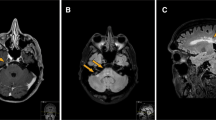Summary
We report two cases of Lyme borreliosis (LB) with erythema migrans (EM) and simultaneous meningopolyneuritis with radicular pain and lymphocytic pleocytosis in the cerebrospinal fluid (CSF). EM and pain disappeared completely under high-dose penicillin G therapy within few a days. Pathological findings in CSF improved. Nevertheless, during and after therapy, neurological signs of LB developed: cranial nerve palsies as well as paresis of extremity muscles with radicular distribution.
Zusammenfassung
Wir berichten über zwei Patienten im Frühstadium einer Lyme Borreliose. Neben einem Erythema migrans deuteten radikuläre Schmerzen und ein pathologischer Liquorbefund auf eine gleichzeitige lymphozytäre Meningopolyneuritis Bannwarth hin. Eine frühzeitige hochdosierte Penicillin G-Therapie führte rasch zu einer vollständigen Rückbildung des Erythems und der Schmerzen. Im weiteren Verlauf entwickelten sich jedoch, während und nach der antibiotischen Therapie, neurologische Ausfälle mit Hirnnerven-Lähmungen und peripheren Extremitätenparesen.
Similar content being viewed by others
References
Schmidt, R., Kabatzki, J., Hartung, S., Ackermann, R. Erythemamigrans-Borreliose in der Bundesrepublik Deutschland. DMW 110 (1985) 1803–1807.
Finkel, M. F. Lyme disease and its neurologic complications. Arch. Neurol. 45 (1988) 99–104.
Kohler, J., Thoden, U. Pain syndromes in tick-borne neuroborreliosis: clinical aspects and differential diagnosis. Der Schmerz 1 (1987) 107–113.
Kohler, J., Kern, U., Kasper, J., Rhese-Küpper, B., Thoden, U. Chronic central nervous system involvement in Lyme borreliosis. Neurology 38 (1988) 863–867.
Wilske, B., Schierz, G., Preac-Mursic, V., Weber, K., Pfister, H. W., Einhäupl, K. M. Serological diagnosis of erythema migrans disease and related disorders. Infection 12 (1984) 331–337.
Wilske, B., Schierz, G., Preac-Mursic, V., von Busch, K., Kühbeck, R., Pfister, H. W., Einhäupl, K. Intrathecal production of specific antibodies againstBorrelia burgdorferi in patients with lymphocytic meningoradiculitis (Bannwarth's syndrome). J. Infect. Dis. 153 (1986) 304–314.
Stiernstedt, G. T., Granström, M., Hederstedt, B., Sköldenberg, B. Diagnosis of spirochetal meningitis by enzyme-linked immunosorbent assay and indirect immunofluorescence assay in serum and cerebrospinal fluid. J. Clin. Microbiol. 21 (1985) 819–825.
Pfister, H. W. Wie wird die neurologisch manifeste Lyme-Borreliose behandelt? Nervenarzt 59 (1988) 687–689.
Dattwyler, R. J., Halperin, J. J., Volkmann, D. J., Luft, B. J. Treatment of late Lyme borreliosis — randomised comparison of ceftriaxone and penicillin. Lancet II (1988) 1191–1194.
Steere, A. C., Pachner, A. R., Malawista, S. E. Neurological abnormalities of Lyme disease: sucessful treatment with highdose intravenous penicillin. Ann. Intern. Med. 99 (1983) 767–772.
Kristoferitsch, W., Baumhackl, U., Sluga, E., Stanek, G. High-dose penicillin therapy in meningopolyneuritis of Garin-Bujadoux-Bannwarth: clinical and CSF data. Zentralblatt Bakt. Mikro. Hygiene (A) 263 (1986) 357–364.
Kristoferitsch, W., Baumhackl, U., Zeiler, K., Stanek, G. Ceftriaxon therapy in meningopolyneuritis Garin-Bujadoux-Bannwarth (abstract). Lyme Borreliosis Update Europe. Baden, Austria, June 2–4, 1987.
Dotevall, L., Alestig, K., Hanner, P., Norkrans, G., Hagberg, L. The use of doxycycline in nervous systemBorrelia burgdorferi infection. Scand. J. Infect. Dis. 53 (1988) 74–79.
Weber, K. Erythema-chronicum-migrans-Meningitis — eine bakterielle Infektionskrankheit? MMW 116 (1974) 1993–1998.
Hollström, E. Successful treatment of erythema migrans Afzelius. Acta Derm. Venereol. 31 (1951) 235–243.
Pfister, H. W., Einhäupl, K. M., Franz, P., Garner, C. Corticosteroids for radicular pain in Bannwarth's syndrome: a double-blind, randomized, placebo-controlled trial. Ann. N. Y. Acad. Sci. 539 (1988) 485–487.
Weber, K. Jarisch-Herxheimer-Reaktion bei Erythema-migrans-Krankheit. Hautarzt 35 (1984) 588–590.
Pal, G. S., Baker, J. T., Wright, D. J. M. Penicillin-resistant Borrelia encephalitis responding to cefotaxime. Lancet I (1988) 50–51.
Mursic, V. P., Wilske, B., Schierz, G., Holmburger, M., Süß, E. In vitro andin vivo susceptibility ofBorrelia burgdorferi. Eur. J. Clin. Microbiol. 6 (1987) 424–426.
Johnson, R. C., Kodner, C., Rusell, M. In vitro andin vivo susceptibility of the Lyme disease spirochete,Borrelia burgdorferi, to four antimicrobial agents. Antimicrob. Agents Chemother. 31 (1987) 164–167.
Dattwyler, R. J., Thomas, J. A., Benach, J. L., Golightly, M. G. Cellular immune response in Lyme disease. Zbl. Bakt. Hyg. A 263 (1986) 151–159.
Garcia-Monco, J. C., Coleman, J. L., Benach, J. L. Antibodies to myelin basic protein in Lyme disease. J. Inf. Dis. 158 (1988) 667.
Martin, R., Ortlauf, J., Sticht-Groh, V., Bogdahn, U., Goldmann, S. F., Mertens, H. G. Borrelia burgdorferi -specific and autoreactive T-cell lines from cerebrospinal fluid in Lyme radiculomyelitis. Ann. Neurol. 24 (1988) 509–516.
Author information
Authors and Affiliations
Rights and permissions
About this article
Cite this article
Kohler, J., Schneider, H. & Vogt, A. High-dose intravenous penicillin G does not prevent further progression in early neurological manifestation of Lyme borreliosis. Infection 17, 216–217 (1989). https://doi.org/10.1007/BF01639522
Received:
Accepted:
Issue Date:
DOI: https://doi.org/10.1007/BF01639522




